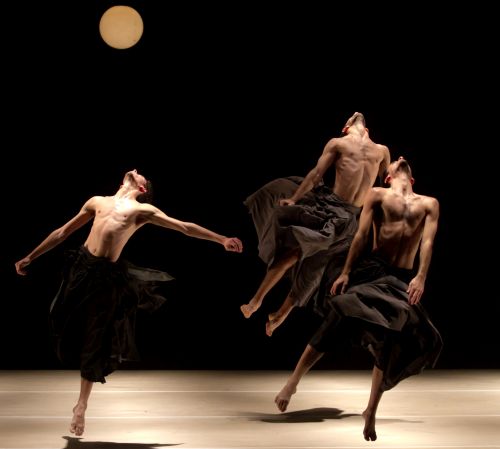 United States Rami Be’er, If At All, Kibbutz Contemporary Dance Company, Wallis Annenberg Center for the Performing Arts, Beverly Hills, 19.11.14-21.11.14 (JRo)
United States Rami Be’er, If At All, Kibbutz Contemporary Dance Company, Wallis Annenberg Center for the Performing Arts, Beverly Hills, 19.11.14-21.11.14 (JRo)

Dancers:
Ben Bach, Tamar Barlev, David Ben Shimon, Roni Ben Simon, Shani Cohen, Daniel Costa, Eyal Dadon, Frida Dam Seidel, Niv Elbaz, Nadav Gal, Martin Harriague, Dafna Ironi, Ilya Nikurov, Anat Oz, Renana Randy, Hagar Shachal, Olga Stetsyuk
Production:
Artistic Director: Rami Be’er
Choreography, Stage Design, Lighting Design: Rami Be’er
Sound Design: Alex Claude, Rami Be’er
Costume Design: Maor Zabar, Rami Be’er
Sound and Lighting: Lior Cohen
We live in frightening times and the works created by many international modern dance choreographers reflect our collective fears. Jarring music, the violence of thrashing limbs, writhing torsos, and collapsing bodies have become incorporated into the dance vocabulary of our age. Offering a sixty-five minute exploration in dance of our “existence as individuals, couples, and society,” the Israeli choreographer Rami Be’er draws from this tumultuous vocabulary in If At All.
Established in 1970, Kibbutz Contemporary Dance Company is one of Israel’s pre-eminent troupes along with Batsheva Dance, seen recently in Los Angeles. But while Batsheva’s choreographer, Ohad Naharin, favors groups of dancers moving in individual patterns, Be’er opts for symmetry and synchronization. With the latter method, patterns emerge and steps are discernable, allowing us to focus on the strong and passionate roster of dancers who form this company.
There are echoes of tribal rites as men swoop in ankle length skirts; there are martial arts inferences as legs kick and fists clench. In a dramatic sequence, a row of male dancers line up at the front of the stage crouched in a version of a yoga child’s pose. Their heads bow and rock up and down, their elbows pound the floor, alternating with their hands. Are they fervently praying or burrowing into the earth? At his best, Be’er tempers ferocity with whimsy. In a sequence of pas de deux in the second half of If At All, what at first seems like a clash between men and women becomes children at play. Are we to infer that life goes on amidst the chaos? That no matter what the disaster awaiting us, the child within us remains hopeful? Be’er says he wants his audience to go on a journey and form their own associations to his work, and so he leaves us to ponder the questions he asks.
The clues to the answers come from the aggressive music collected for If At All with sound design by Alex Claude and Be’er. Keyboard, mournful cello, dissonant sound effects incorporating sirens, gunshots, chatter, spoken word, along with the occasional song, form a tortured roadmap that Be’er wishes us to follow. I wonder, on this choreographic journey, whether the movements would have projected the same vehemence had not the music been so harsh. What would we have made of women dancing fervently in carpet squares of light had we heard a Bach Cello Suite instead? Though my question may have little or no relevance to Be’er’s vision, his musical decisions certainly are food for thought.
The dancers’ motions are coordinated with the precision of the Willis in Giselle or the swans in Swan Lake. However, the general impression is one of turning inward rather than outward, of bowed heads and rounded shoulders, rather than lengthening bodies reaching heavenwards. The exceptions are the upward leaps of the men and the lifted arms of the women. In one striking moment a female dancer with long black hair is lifted and held above the heads of a half dozen men like the Chosen One in Nijinsky’s Rite of Spring. But once again, we retreat to the earth as all the principals drop to the ground and the woman rolls over the bodies of the reclining men – a line of logs on a river. It’s a powerful and poignant moment. One wished for a few more of these to mitigate the harsh reality of twenty-first century man in a dangerous world.
Jane Rosenberg